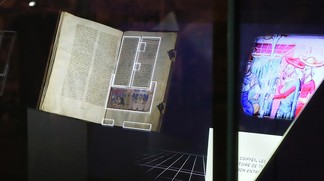The Holographic Showcase
During the time I spent as a post-doctoral fellow in the DHLAB, I participated in a project joint with OZWE Kenzan and the Fondation Bodmer to develop a holographic showcase.
A holographic showcase
The goal of the holographic showcase is to augment an ancient manuscript with digital information. For example, details of the page can be highlighted and associated to an animated animation.

To do that, a screen is placed horizontally above the manuscript. A special glass pane is positioned so that the user can see the manuscript through it, as well as the image reflected from the screen. This way, the displayed image appears to be directly on the book.
A museographic Device
Such a showcase is not just a fancy TV. My role in the project was to develop the part responsible the detection of visitors, using Asus’ Xtion and OpenNI’s NiTE. This allows to explore a new kind of interaction between a visitor and a fragile artifact. In this first application, the detection simply triggered the animations, leaving a “quiet” showcase when no one was around, instead of distracting graphics looping continuously.
I was also responsible for integrating the Unity3D animation augmenting the manuscript and the lighting control into a system suitable for a museum, i.e. quiet (visitors do not want to see boot or error messages) and robust (curators do not want to reboot the system every now and then).